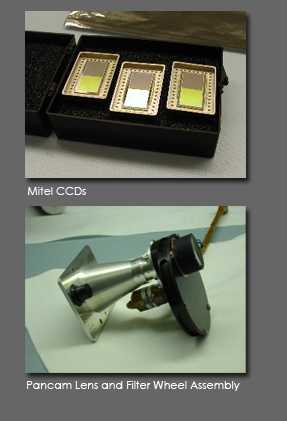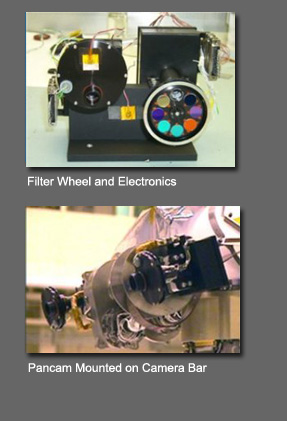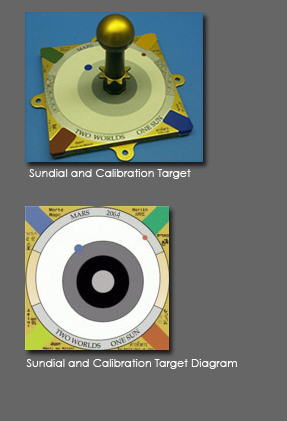About the Pancam
SCIENCE PAYOFF
Pancam images can be stitched together to build multispectral panoramas of the full scene around the rover, and even full three-dimensional models of the surrounding terrain.
Panoramic imaging provides information on the morphology of the site, on the lithology, distribution, and shape of nearby rocks, and on local features like fluvial terraces, depositional bars, and dunes that may be present. This information will be relevant to understanding what processes have affected the site, particularly when merged with compositional data.
Multispectral panoramic imaging will provide information on the mineralogy of materials to supplement and complement data obtained by other instruments.
Images of the Martian sky, including direct images of the sun, help determine dust and aerosol opacity and composition.
The generated digital terrain models help guide rover traverse paths.
Pancam provides information to guide the selection of the most interesting targets to look at with other rover instruments.
PANCAM TECHNICAL SPECIFICATIONS
Download the Technical Briefing (PDF).
270 g each
3 W power for CCD, electronics
3.5 W power for a small warmup heater
"Visor" that swings cameras in elevation
1.52 m above surface with PMA in deployed position
Separate Pancam and mini-TES actuators
Pancams upside down relative to each other because of volume constraint when mast stowed
Operating temperature range: -55°C to 0°C
Survival temperature range: -110°C to +50°C
1024x2048 pixel Mitel CCDs
1024x1024 pixel Active Area
Equivalent to 20/20 human vision
Field of view: 16.8° x 16.8° per eye
Field of regard: 360° az., ±90° el.
Angular resolution 0.28 mrad/pixel
Focal length 38 mm, f/20 optics
Optimal focus from 1.5 m to infinity
Stereo separation 30 cm, Toe-in 1°
8 filters per eye cover 400-1100 nm (near-UV to near-IR)
Onboard cal target, fiducial marks
Onboard wavelet compression
Integrated with mini-TES design
TWO WORLDS, ONE SUN
The calibration target for the Pancam also doubles as a sundial. Its design has been influenced by the suggestions of kids across the United States. The sundial's face shows rings of the orbits of Earth and Mars, and its sides contain stick figures representing the people of Earth. The word "Mars" is inscribed in 22 languages, and the text "Two worlds, one sun" is written out across its face. There is also a description of the peaceful intent of the mission written on the sundial.
The scientific function of the sundial is to serve as a four-color calibration target to test that the Pancam is working correctly. The colors, made of a silicone rubber compound, each contain a different mineral. The target will be frequently viewed by the Pancam on Mars.




